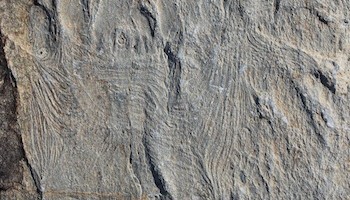
These ripples may be the earliest evidence of muscle tissue ever found. The 560 million-year-old fossil was found on Newfoundland’s Bonavista Peninsula and were left behind by an organism named Haootia quadriformis, an ancient relative of jellyfish. (Photo credit: Alexander Liu)
A 560 million-year-old fossil from Newoundland’s Bonavista Peninsula may record the oldest evidence of muscle tissue, according to a new paper.
The fossil comes from a time known as the Ediacaran period, renowned for its preservation of the first large and complex organisms known. Most Ediacaran organisms were flat, sheet-like, or frond-like creatures whose relationships to modern organisms are hard to pin down.
This particular fossil organism, Haootia quadriformis, contains symmetrical fibrous structures that the authors interpret as muscle tissue. The authors suggest that H. quadriformis could be an early member of Cnidaria, a group whose living members include jellyfish and sea anemones.
Original research paper published in the Proceedings of the Royal Society B on August 26, 2014.
Names and affiliations of selected authors
